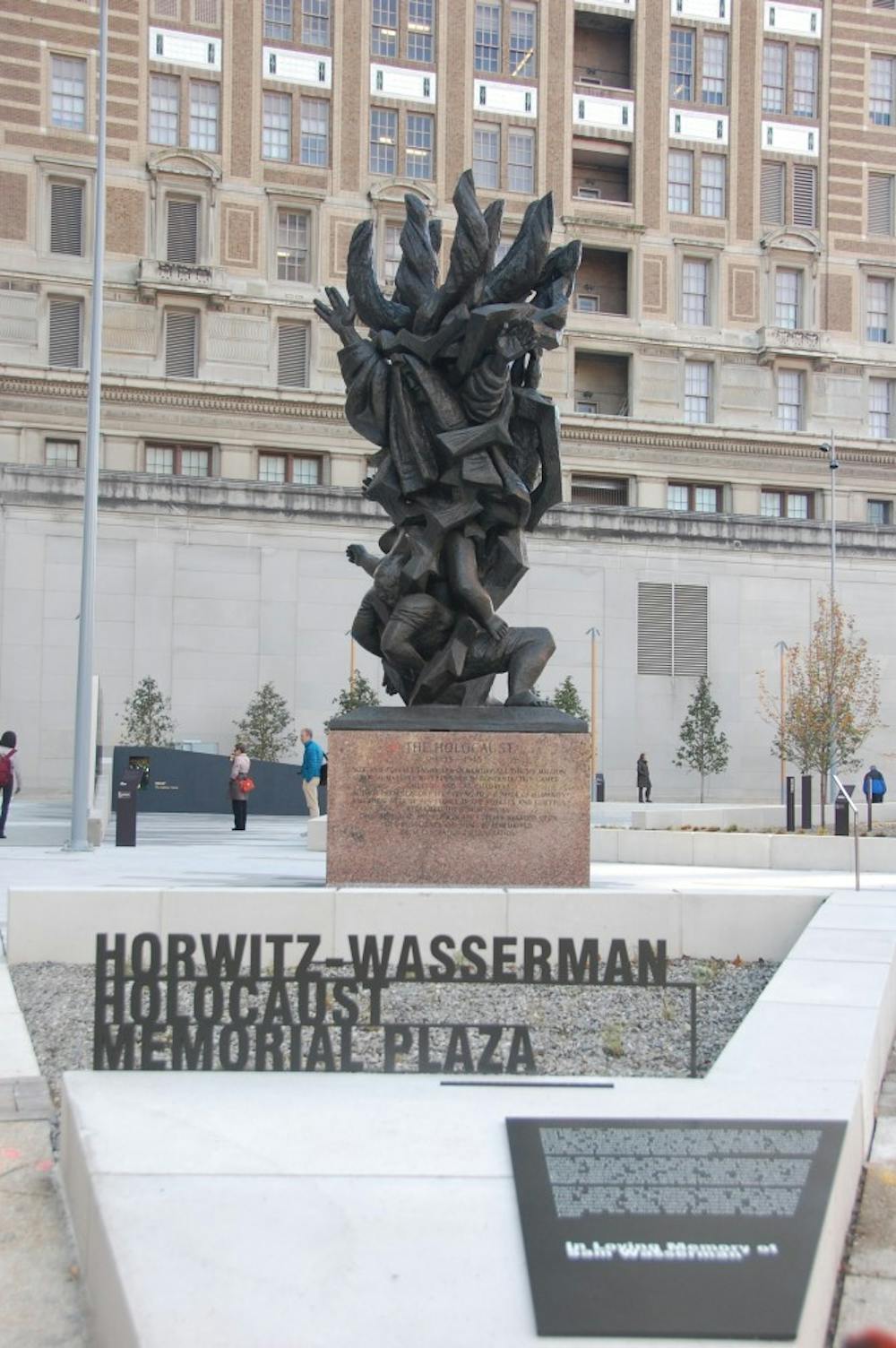At the intersection of Arch and 16th Streets, shadowed between buildings of glass and brick and facing the incessant traffic of Benjamin Franklin Parkway, sits the Philadelphia Holocaust Memorial Plaza. Newly opened after reconstruction by the Philadelphia Holocaust Remembrance Foundation on Oct. 22, 2018, the plaza is a sliver of history suspended within the fast flowing pace of Center City. In collaboration with architecturally acclaimed design firm Wallace Roberts & Todd, the Foundation officially broke ground for the Plaza's reconstruction on Nov. 28, 2017 as a means of restoring and expanding the original monument for a wider audience.
Created by internationally renowned sculptor Nathan Rapoport and presented by a group of Holocaust survivors and the Federation of Jewish Agencies of Greater Philadelphia on Apr. 26, 1964, Monument to Six Million Jewish Martyrs was the first public monument in North America dedicated to the six million European Jews who had perished during one of the greatest genocides known to man. As such, the Foundation had been leading efforts since 2006 to preserve the Monument and revitalize the site as a center of education and memorialization of the Holocaust for future generations. The memorial site, though unprecedented in American history, remained neither well–exposed to the public eye nor often–used, beyond hosting the annual Holocaust remembrance event in recent decades, until this recent reopening.

The Plaza exudes a sense of calm. It calls you to put aside the distractions of the present and let them fade into white noise. Reading its inscriptions of history and gazing at its memorials, the atrocities of the past are called to memory so they might never be forgotten. We need not have been there to understand what had been done and what should never be done. Leon Bass, a young black soldier serving in the army and one of the earliest witnesses of the German–abandoned Buchenwald camp, recalls his reaction towards the horrors of the Holocaust as one of epiphany. "Something happened when I walked through the gates...I began to realize that human suffering is not delegated just to me and mine. Human suffering touches everybody. All people can suffer."
The centerpiece of the Plaza is Rapoport's original monument: a sculpture of men, women, and children engulfed in what appear to be thorn–infested vines. Legs scramble for purchase, arms flail for safety, hands grasp for freedom—each element of the body speaks of suffering and despair. Yet it is also a work of hope, hope that such atrocity may only ever appear in bronze and stone, never again in reality.
Further in the Plaza are the Six Pillars, presented in pairs, representing the horrors of the Holocaust and "...contrasting it with American constitutional protections and values." "Human equality" stands adjacent to "The Master Race;" "Protecting Life and Liberty" rests beside "Death Camps." The counterparts of each respective pair sit close together, yet idealistically miles apart. Another feature, the Tree Grove, though sparse and thin, serves as a representation of the woods which sheltered resistance against the Nazi regime. The trees, barely beyond saplings, stand straight and tall in the autumn chill. They embody the spirit of those who suffered, fought, and died for a cause against hatred and bigotry. In the years to come, this grove will grow, their branches and trunks then serving as cover for visitors against harsh winter wind.

In front of the Tree Grove lie the Train Tracks. Uprooted from the railroad running adjacent to the Treblinka Death Camp in Poland, the lengths of rusted steel bars are embedded in gray concrete—physical reminders of the millions who were deported to their deaths. Victims were stripped of clothing upon exiting the freight cars, forced into "showers," and poisoned with carbon monoxide. The tracks "...recall the industrial efficiency that defined the Nazi's 'Final Solution to the Jewish Question,'"—that is, extermination.
On the narrowest side of the Memorial Plaza is the Eternal Flame. Flickering in the alcoved Remembrance Wall, the flame serves as "a symbol of hope and light, embodying...commitment to never forget." So as long as light is shed and heat is given, so will people's memory of the Holocaust never die. Standing across from the Flame, on the other side of the Plaza, is the Theresienstadt Tree. This silver maple is a sapling of the original maple which was planted by teacher Irma Lauscher in 1943 in Camp Theresienstadt in the Czech Republic. There, deported children were educated as a means of propaganda while concealing the camp's genocidal purpose. Beyond writing poetry and painting pictures, the children nurtured the tree until liberation, during which survivors commemorated the tree, saying "As the branches of this tree, so the branches of our people!" Today, its sapling is rooted in gravel but reaching skyward. Standing in the midst of the Memorial Plaza, immersed in this haven of remembrance, the spirit of the Holocaust victims' hopes and hardships live on.
The Plaza is a memorial of all those lost who should not have been lost. But above all that, for those visiting or even just passing by, the Plaza is a remnant of history, never to be erased or forgotten, lest the cycle ever repeats itself again.







